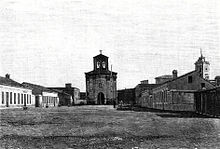Isla de Isabel II
 The island as seen from the Moroccan coast. | |
 | |
| Geography | |
|---|---|
| Location | Alboran Sea |
| Coordinates | 35°10′55″N 2°25′46″W / 35.18194°N 2.42944°W |
| Archipelago | Chafarinas Islands |
| Area | 0.153 km2 (0.059 sq mi) |
| Highest elevation | 35 m (115 ft) |
| Administration | |
Isabel II Island (Spanish: Isla de Isabel II) is the central island of the Chafarinas Islands, in the Mediterranean Sea. The island belongs to Spain. It is located only 4 kilometres (2.5 mi) away from the North-African shore, in front of the Moroccan town of Ras Kebdana. Its area is 0.153 km2 (15.3 ha), and there is a military base and a church.
Name
[edit]The name of the island comes from Isabella II,[1] Queen of Spain from 1833 to 1868.
Geography
[edit]Displaying a rounded shape,[2] it has a total area of 0.153 square kilometres (0.059 sq mi).[3] Substantially flatter than the Isla del Congreso, it reaches a maximum height of 35 metres above sea level.[2]
History
[edit]
Archeological remains found in the island suggest the existence of an outpost intended for sheltering ships by the 1st century BC, a time when the North-African coastline thrived during the reign of Juba II.[4]
Along the other two islands of the archipelago (Isla del Rey and Isla del Congreso), it was occupied in 1848 by Spain,[5] that alleged terra nullius,[6] anticipating French intentions to do the same from Algeria.[7] General Francisco Serrano took possession of the islands bringing two ships from Málaga.[8]
The works of conditioning of the island of Isabel II suffered a major setback after the passing of a strong storm in March 1849.[9] Then the question arose of whether the stay in the archipelago was worth it or not.[10]
Between 1910 and 1915 the island was connected through a dike with the Isla del Rey.[11]
Electric lighting was installed on the island in 1922.[12]
Population
[edit]The island is the only inhabited island of the archipelago. It currently hosts a military garrison with personnel from the Ministry of Environment of Spain, as the islands are a National Reserve protected because of the wealth of their natural species.
References
[edit]Citations
[edit]- ^ Alamán, Lucas (1853). Diccionario universal de historia y de geografía. Librería de Andrade. p. 166.
- ^ a b Pineda & Barrera 2013, p. 10.
- ^ Calderon, Cruz & Ruggeri 2018, p. 85.
- ^ Aragón Gómez 2013, p. 141.
- ^ Andrews, George Frederick (1911). "Spanish Interests in Morocco". American Political Science Review. 5 (4): 553–565. doi:10.2307/1945023. ISSN 0003-0554.
- ^ Jiménez García-Carriazo 2018, p. 216.
- ^ Madariaga 2012.
- ^ Cal, Juan Carlos de la; Ruiz, Sara (14 July 2002). "Las otras "perejiles"". El Mundo.
- ^ Esquembri Hinojo 2013a, pp. 194–195.
- ^ Esquembri Hinojo 2013a, p. 196.
- ^ Escámez Pastrana 1989, p. 47.
- ^ Esquembri Hinojo 2013b, p. 22.
Bibliography
[edit]- Aragón Gómez, Manuel (2013). "De las tres ínsulas a Jafarín. Las Islas Chafarinas y su entorno en la Antigüedad y Medievo" (PDF). Aldaba (37): 125–156. ISSN 0213-7925.
- Calderon, F.J.; Cruz, Elena; Ruggeri, G. (2018). "The Chafarinas Islands: Borders, Environmental Protection and Sustainable Tourism". In Calò, Patrizia; Ruggieri, Giovanni (eds.). Book of Full Papers - OTIE ICIT 2018 (PDF). pp. 83–98. ISBN 978-88-943724-1-0.
- Escámez Pastrana, Antonio Manuel (1989). "Las Islas Chafarinas y su problemática medio ambiental" (PDF). Aldaba (13). Melilla: Universidad Nacional de Educación a Distancia: 45–69. doi:10.5944/aldaba.13.1989.20153. ISSN 0213-7925.
- Esquembri Hinojo, Carlos (2013a). "Las islas Chafarinas, desde 1848 hasta finales del siglo XIX" (PDF). Aldaba (37). Melilla: Universidad Nacional de Educación a Distancia: 191–219. doi:10.5944/aldaba.37.2013.20543.
- Esquembri Hinojo, Carlos (2013b). "Chafarinas durante el siglo XX". Aldaba (38). Melilla: Universidad Nacional de Educación a Distancia: 9–42. doi:10.5944/aldaba.38.2013.20546.
- Jiménez García-Carriazo, Ángeles (2018). La ampliación de la plataforma continental más allá de las doscientas millas marinas.Especial referencia a España. Madrid: Dykinson. ISBN 9788491486770.
- Madariaga, María Rosa (7 September 2012). "Los intentos de deshacerse de los enclaves". El País.
- Pineda, Antonio; Barrera, José Luis (2013). "Geología de las islas Chafarinas" (PDF). Aldaba (37). Melilla: Universidad Nacional de Educación a Distancia: 9. doi:10.5944/aldaba.37.2013.20542.
